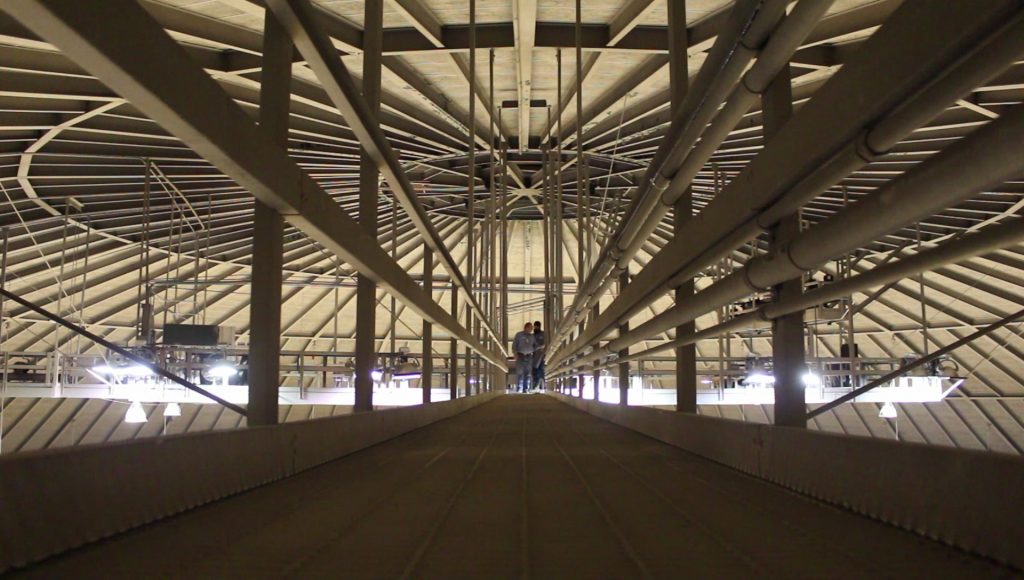Light spread across the court, spilling into the stands and onto the stairwells of the beloved Tad Pad. But something was missing.
One light, a large bucket light, had burned out, leaving a shadowy area on the court where, just a few years ago, the Rebels would’ve been representing their school. Two electricians looked up.
The noise of bolts and cables creaking and groaning added to the ambient electrical hum of the Tad Smith Coliseum as the men walked down the catwalk, joining with the click-clack of their work boots across the grate floor to sing out the song of a day’s work.
From a spectator’s point of view, this may seem like a typical part of any work day for the two Ole Miss Facilities Management engineers, watching as they walked confidently stories above the former home of Rebel basketball, to switch out that one single light bulb. The truth is vastly different.
Senior Electrician Rusty Leslie was joined by Electrician Jesse Jenkins, a recent addition to the Ole Miss team. Together, the two climbed high above the court to begin the process of removing the burnt-out bulb, a task that could call upon multiple methods of varying difficulty.
“Everything requires either different equipment, or its in a different location, (or they’re) different types of lights,” Jenkins said. “Some of them you need a ladder. Some of them you need a bucket truck, some of them you almost need climbing gear to get to.”
Jenkins, who has changed more than 100 lightbulbs in academic, athletic and residential buildings while working at Ole Miss, said every bulb job is different.
Small differences such as varying styles of lighting, accessibility to the light housing and even different building types can vastly change the approach to a job that one may have thought was as simple as changing a light bulb.

Senior Electrician Rusty Leslie, left, and Electrician Jesse Jenkins, right, return from the upper Tad Smith Coliseum catwalk after changing a burnt-out bucket light bulb on Nov. 13. The two usually spend their days fixing tripped breakers and fizzled circuits, but this day, their labors and experience were needed elsewhere. Photo by David Ballowe
For this particular job, the two men had to work together. Leaning over the railing, the men removed the bolts securing the light housing to the catwalk. Once the bolts were loose, the men both grabbed the housing and lifted.
The sounds of scraping metal accompanied by exhalations and gritted teeth added to the lullaby of labor as the light was hoisted over the railing and onto the catwalk. The light housings are surprisingly weighty. Leslie said it takes two people to lift the light over the rail.
“It’s not a one-man-job,” Leslie said. “They’re probably anywhere from 50 to 80 pounds. Maybe 100 pounds. They’re pretty heavy,”
After placing the housing onto the floor of the catwalk, they removed the outer casing of the housing itself in order to reach the glass cover, behind which the fizzled light waited, patiently, to be removed.
The glass was unclipped from the housing and hinged upwards, held by Jenkins while Leslie reached in and unscrewed the burnt bulb, roughly the size of a cantaloupe. The busted bulb was replaced with a new one, and was placed in a box to be discarded.
The process was repeated in reverse, piecing back together the light mechanism that stood waist-high to the two men. Once reassembled, the light was hoisted back over the railing and put in place, ready to illuminate the silent stands and vacant benches.
Approximately 50 light bulbs will burn out monthly, according to Assistant Director of Facilities Operations Ron Huckaby, who said they typically change the bulbs before they burn out.
“A lot of our lights are being replaced with LED lights, which last much longer,” Huckaby said.
Leslie mentioned this type of catwalk work isn’t usually on his everyday schedule. Workers with General Maintenance, another pivotal department in the process of preserving and maintaining the Ole Miss campus, usually takes the brunt of the bulb work. Leslie said he and his colleagues typically spend their work days fixing tripped breakers, faulty circuits and blown transformers.
“Troubleshooting takes the most amount of time when fixing a circuit,” Huckaby said. “After figuring out the problem it does not take a lot of time to fix the circuit, around 15 to 20 minutes.”
Oddly enough, it seems that the Oxford campus has a major issue with small, tree-dwelling rodents. Grove squirrels, as they are affectionately called around campus, are a staple in the Ole Miss
community and a thorn in the side of Facilities Management.
“We have a lot of problems with squirrels here at Ole Miss and in the Grove,” Leslie said.
Naturally crafty, these furry creatures can chew up wires in seconds, and can blow an entire electrical transformer in an instant, causing major electrical issues throughout campus.
“We have probably had around 20 instances with squirrels blowing fuses in the past two to three weeks,” said Huckaby.

Oxford firefighters and UM Facilities Management remove a scorched squirrel carcass from an exploded transformer on campus on April 18, 2017. A squirrel bit power lines, leading to a destroyed transformer. File photo by Taylar Teel






